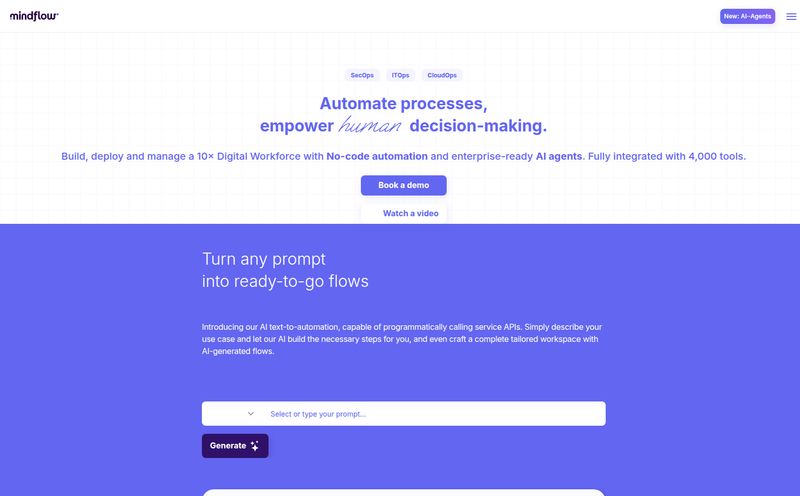As someone who's spent years swimming in the deep end of the SEO and digital tools pool, I get a little thrill when I hear about a new platform that promises to change the game. We've all seen the pitches. 'Revolutionize your workflow!' 'The last tool you'll ever need!' Most of it is just marketing fluff. But every now and then, a concept comes along that genuinely makes you lean in closer.
That was me with Birdlabs. The promise was electrifying: build custom, AI-powered internal business tools 10 times faster and 10 times cheaper. Sounds pretty good, right? So, I went to check it out, ready to see the future of rapid development. And what did I find?
A 404 error. Not just any 404, but a cold, technical one: `DEPLOYMENT_NOT_FOUND`.
It’s like arriving at a much-hyped restaurant opening only to find a locked door and a note from the landlord. It’s a mystery. And frankly, it's way more interesting than just another product page. So what was Birdlabs, and where did it go? Let’s play detective.
What Exactly Was Birdlabs Supposed to Be?
Piecing together the digital breadcrumbs, Birdlabs was positioned as a radical solution for a problem I see constantly. Businesses, big and small, are drowning in operational inefficiencies. They need a custom tool—a dashboard to track obscure metrics, an automated report generator, an internal wiki powered by AI to answer employee questions. But getting that tool built is a nightmare. It means pulling developers off of customer-facing products, spending a fortune on outside agencies, or adding it to a backlog that’s already a mile long.
Birdlabs aimed to short-circuit that whole process. The idea was to let you build these highly specific, intelligent tools with the simplicity of writing a Word document. No complex coding required. Just define your business requirements, and poof—a functional, AI-enabled piece of software appears. It was a classic no-code or low-code play, but aimed squarely at the internal workings of a company and supercharged with AI.
The Alluring Promise of Speed and Savings
The headline claims of being "10x faster and 10x cheaper" are the kind of thing that makes a seasoned marketer like me skeptical. But let's break it down, because in the world of custom software, it's not entirely unbelievable.
A 10x Speed Boost? Let's Be Real.
Think about building a simple internal dashboard the old-fashioned way. You need meetings to define the scope, a UI/UX designer to mock it up, a frontend dev to build the interface, a backend dev to connect the data, and a project manager to keep it all from falling apart. That can take weeks, even months. A platform like Birdlabs, by providing pre-built components and abstracting away the code, could genuinely turn a multi-week project into an afternoon's work. So, is 10x an exaggeration? Maybe. But is it in the right ballpark for some projects? Absolutely.
Making AI Integration Accessible
This, for me, was the most exciting part. Everyone's talking about AI, but very few companies are actually using it effectively in their day-to-day operations. It's complicated, it's expensive, and it requires specialized talent. Birdlabs promised to treat AI as just another building block you could snap into place. Imagine building an onboarding tool that uses an AI to answer new-hire questions, or an inventory system that uses AI to predict when you'll need to reorder stock. That's a powerful proposition, taking AI from a boardroom buzzword to a practical tool on the ground.
The Smart Trade-Off: Function Over Form
Here’s the bit that told me the Birdlabs team actually understood the market. One of their stated 'cons' was that they sacrificed aesthetic customizations for speed. Thank you! Internal tools don’t need to win design awards. They don't need pixel-perfect animations or trendy gradients. They need to be fast, reliable, and solve a problem. It’s the difference between a custom-tailored suit and a reliable, comfortable pair of work overalls. One is for show, the other is for getting work done.
By focusing purely on internal business tools, they dodged the massive complexities of building customer-facing apps and could concentrate on pure functionality. It’s a niche, but its a deep and underserved one.

Visit Birdlabs
So, Where in the World is Birdlabs?
This brings us back to that stark `DEPLOYMENT_NOT_FOUND` message. What does it mean? In my experience, it's not a typical "website down" error. It suggests the entire application, the very foundation of the service on its hosting platform (likely a modern cloud provider like Vercel or Netlify), has been removed. It’s been… un-deployed.
There are a few possibilities:
- The Pivot or Shutdown: This is the most likely scenario in the brutal world of startups. They may have run out of funding, failed to find product-market fit, or simply decided the project wasn't viable. The startup graveyard is filled with brilliant ideas that just didn't make it. According to research from CB Insights, nearly 38% of failed startups simply run out of cash.
- The 'Acqui-hire': A larger company might have seen the potential and bought the company not for its product, but for its talented team. In these cases, the public-facing product is often shut down as the team gets integrated into the parent company.
- Stealth Mode: It's possible they've taken the product private to re-tool before a bigger launch, but the 'deployment not found' error feels more permanent than that.
Whatever the reason, the digital ghost of Birdlabs is a classic Silicon Valley story. A bright flash of promise, and then... silence.
Even as a Ghost, Birdlabs Teaches Us Something
You might be thinking, "Great, so you wrote a whole article about a tool that doesn't even exist." But that's missing the point. The idea of Birdlabs is more important than the platform itself. Its ghost tells us where the market is heading.
The demand for what Birdlabs was offering hasn't gone away. If anything, it’s stronger than ever. Every business leader I talk to is desperate to do more with less, to automate internal processes, and to tap into AI without hiring a team of data scientists. The need is real and it is massive.
The good news is that other platforms are working to solve this same problem. Tools like Retool, Appsmith, and Bubble are all fantastic players in the low-code/no-code application development space. They allow developers and even non-developers to build robust internal applications much faster than with traditional code. They might not all have the same AI-centric marketing as Birdlabs, but they are delivering on that core promise of speed and efficiency.
The disappearance of Birdlabs isn't a failure of the idea. It's just a reminder that execution is everything. For every tool that makes it, ten others become digital ghosts just like this one.
Frequently Asked Questions about AI Tool Builders
What was Birdlabs?
Birdlabs was a platform designed to help businesses build custom, AI-powered internal tools very quickly and affordably. It promised a "10x faster, 10x cheaper" solution, focusing on functionality over aesthetics for internal business applications.
Was Birdlabs free?
There was no public pricing information available before the platform went offline. However, its marketing as "10x cheaper" suggests it was a paid, commercial product, likely with a subscription-based model. It was not intended to be a free tool.
Why are internal tools so difficult to build?
Building internal tools is difficult because it requires scarce and expensive developer resources. These projects often have to compete for priority against customer-facing features that generate direct revenue, so they get pushed to the back of the line, even if they could save the company significant time and money.
What are good alternatives to Birdlabs?
For building robust internal tools and applications with less code, platforms like Retool, Appsmith, and Bubble are excellent, well-established alternatives. Each has its own strengths in terms of complexity, data source integrations, and ease of use.
Is 'no-code' AI really possible for complex tasks?
Yes, to an extent. No-code AI platforms typically work by connecting to powerful, pre-trained AI models (like those from OpenAI or Google) via APIs. Users can build workflows that send data to these models and get results back without writing code. This is great for tasks like text summarization, data classification, and simple Q&A. However, building a truly novel AI from scratch still requires deep technical expertise.
What does 'DEPLOYMENT_NOT_FOUND' actually mean?
This specific error typically comes from modern hosting platforms (like Vercel or Netlify) and means that the project or application that was supposed to be at that web address has been completely removed or deleted from the hosting account. It's more than just a server being down; the files themselves are gone.
The Story Isn't Over
So, RIP Birdlabs. It was a fascinating concept. A shooting star in the crowded night sky of tech startups. While its own deployment may not be found, the path it pointed towards is clearer than ever. The future isn't about every manager becoming a coder. It's about giving every manager the power to build the tools they need.
That future is still being built, one line of code—or one no-code block—at a time. And I, for one, can't wait to see who finally cracks it.
References and Sources
- CB Insights: The Top 12 Reasons Startups Fail
- Retool: The fast way to build internal tools
- Appsmith: The open-source Retool alternative
- Bubble: The best way to build web apps without code



